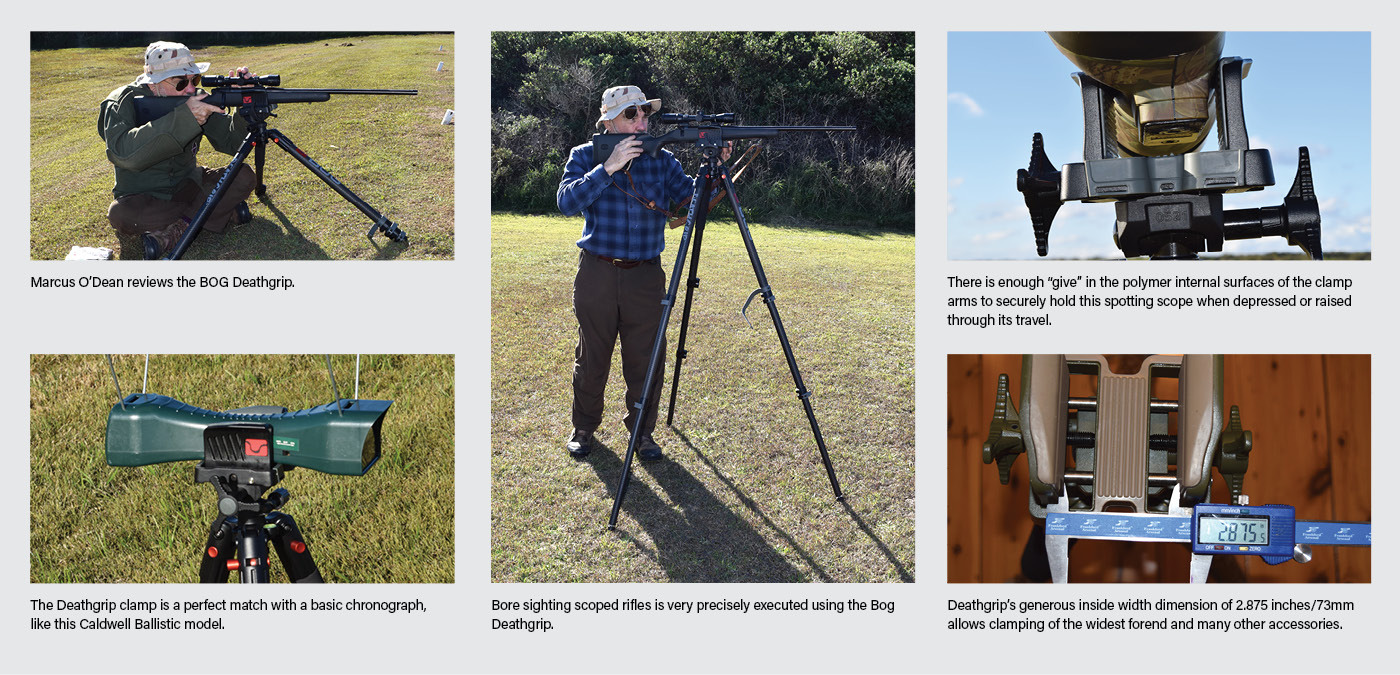As shooting performance aids, these new-to-the-market supports are a definite advance on their predecessors. I’ve used Bog shooting sticks in bipod configuration to whistle in foxes to stands, take deer from sit-and-wait hunts and to take my best fallow buck ever when I was exhausted at day’s end. I have found them to be excellent, rugged hunting companions while doubling as tough walking aids.
I’ve put the ruler over three versions of the latest BOG Deathgrip tripod.
While I do not compete in the precision rifle disciplines these products aim at (pardon the pun), I am no stranger to improvised rested shooting in the hunting field and in sniper-style matches.
I know a steady rest and the Bog Deathgrip delivers.
Alloy
Two Bog Deathgrips I used were of aluminium-alloy leg construction (35mm diameter for top section). One in black anodised finish and the other in a durable Mossy-Oak camouflage. These weighed 3.9kg according to my digital luggage weigher, 44 grams heavier than claimed on the box.
Carbon
While outwardly identical to the other two Deathgrips, the legs of this version are carbon fibre. It tipped the scale at 3.49kg, 90 grams heavier than box weight. So the carbon weight advantage is just under a pound (0.41kg) in the old money.
Gram shavers out there would be sacrificing steady holds in competition using flimsier setups. I found the weight a little disconcerting at first, but you realise very quickly that these units offer dead-steady support, unobtainable with lighter setups.
Tripod Construction
These tripods are undeniably solid and rugged, beautifully finished and executed in quality materials. They should give years of use if minimally maintained by owners. What I really like about them is that there is no centre column to brace the legs with struts, inevitably limiting adjustability.
The BOGs are solid enough not to need them and consequently, they sport three typical degree settings – 20, 45 and 85 degrees – on each leg. These equate to standing, sitting and prone positions and I found the standing one a smidge high for my “elfin” frame; easily fixed when you adjust the leg heights. Mark them with a Texta or fluro paint (on black) and you are set up to go every time. You brace the legs at those angles by use of anodised contrasting friction plungers with recessed numerical indicator windows – impressive.
To move from one setting to another, pull the leg in a little back towards vertical and reset the number setting and spread the leg to that angle, where it locks; a brilliant concept that operates seamlessly
and smoothly.
At the three legs’ bottom extremities are replaceable screw-in rubber convex-profiled feet which are profiled large enough to give long service and house steel spike extensions for deployment for extra purchase in hard soils or baked hard mud. It is these little details that pay off in an extra “X” here and there and that wins matches when it counts.
Adjusting legs is child’s play, achieved by flipping out three rugged polymer cam-locks on each leg. They lock up very positively, giving great peace of mind that your tripod won’t collapse when the action gets fast and furious. At the 20 degree setting, the base of the Deathgrip cradle was 1.52 metres above ground at full height. With all legs fully retracted that measure was 690mm and at the 85-degree prone setting with legs retracted, the height was 255mm.

Deathgrip — the heart of secure support
The addition of the Deathgrip clamp is fundamental to rock-solid, clamped and cradled support of rifles with a wide range of stock dimensions. In testing at 200 metres, I clamped in
two narrow-stocked rifles to boresight, a shortened club SMLE rechambered to 7.62 x 39 with a central target sight attached and my Mauser M18 in 6.5 Creedmoor. Never has bore sighting been less of a chore. Using sandbags from a table or the ground have always necessitated many checks and readjustments. This time, I did it all from the standing position and the rifles both came in within 30cm for their first shot to adjust in for the match.
Now, I had to shoot sitting unsupported in the subsequent match to count and I did just fine. Had
the rules allowed me to use the BOG Deathgrip, I could anticipate shooting the three-quarter inch pinhole into just one big hole. When I did shoot sitting from the Deathgrip to assess how five shots fell, the resultant 1.5-inch group was indistinguishable from a prone bag-rested group that the Mauser would normally yield.
The Deathgrip’s cradle maxes out at 2.85 inches/72.4mm wide (internal), which fits a very wide forend or it will comfortably support and grip a large spotting scope and many conventional chronographs. The interior cradle surface is a fairly stiff, but giving, ribbed polymer which proved excellent for its intended use.
Head Controls
Three simple mechanisms make adjustments limitless for all practical purposes:
- Low down on the shaft of the Deathgrip is a cylindrical knurled knob which allows 360 degree horizontal rotation of the head, regulated by the tension applied by the user.
- Higher up on the left is a three-spoked metal clamp which, when released allows the head to tilt down back through a large range
- An identical handle on the right side moves
a thread under the clamp to wind both clamp uprights equally inboard and outboard of centre
to tailor use for different width forends.
The Wrap
Knowing BOG products quality from the past, I expected good things and what I got was an experience exceeding all expectations. I recommend these tripods without reservation.
NOTE
For more specific hunting use, BOG produce the Original DeadShot FieldPod, The BOG FieldPod Rest and the BOG Deathgrip Sherpa ArcaSwissTripod in Carbon Fibre among others.






